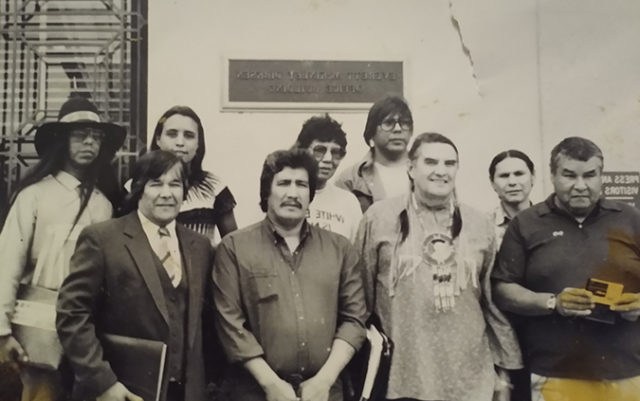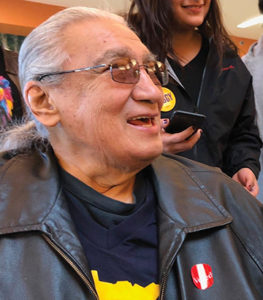
By Winona LaDuke
Pillars of courage hold up the justice we know we deserve. The passing of Marvin Manypenny, a lifelong champion of the rights of the Anishinaabe, reminds us of our responsibility to make our country and nations stronger. Manypenny died in White Earth on January 26 at the age of 72.
In l988, Manypenny and others sought justice for the theft of land from the White Earth reservation. Manypenny and George Fineday, Sr., were the first-named plaintiffs in two consolidated lawsuits brought by thirty-five enrolled members of the White Earth Band of Chippewa.
The theft of White Earth
The White Earth Ojibwe tribe had thousdands of acres of land stolen from them through deception, confiscation or unfair laws. Our land was once covered with trees, buffalo and the most plentiful of wild rice. But our wealth became our poverty as the White Earth reservation’s lands and trees were stolen, and our people made into refugees in our own land. As oil was to the Osage nation (ultimately a source of much violence), our trees were the source of violence in law and in practice. That is the history of how mansions and Minneapolis were built off the blood of the Ojibwe.
Our treaty of l867 was intended to secure a homeland for the Anishinaabe who were being forced off our lands: a place full of white pine, great prairies, lakes and maples. As Frederick Weyerhauser and other lumber barons looked to the vast white pines of the reservation, they had Senator Knute Nelson pass a law. The 1889 Nelson Act opened up the reservation to sale and took the best trees – the four northeast townships of the reservation. That’s Clearwater County today.
A year later, Minnesota ranked first in logging. In 1889-1890, over 11 million board feet of lumber was taken from the White Earth reservation, building the mansions of Minneapolis and the Congden Mansion of Duluth. The next year 15 million board feet were cut, the following year l8 million board feet. Weyerhauser’s Little Falls based logging company sawed enough timber to circle the globe six times, all in one year. Those were our trees.
Not content to steal only the trees, the state of Minnesota, counties and land swindlers like Lucky Waller and Fred Sanders set their eyes upon the White Earth people. The stories are heartbreaking, land stolen from blind women, veterans, swindles for a bag of groceries. It was so egregious that the Detroit Lakes Newspaper referred to the orgy of theft and destruction as “fleecing the Indians”.
By l904, 99% of the reservation was allotted, and ten years later, less than fourteen percent of the homeland was still in our hands. By l934, only 7890 acres of the 837,000 acre reservation was still held by the White Earth tribe.
2415 Land Claims research project
In the l970s, Clearwater County sought to clear title to some land held by descendants of Zay Zah, or Charles Aubid. That’s called a quit claim deed. On October 21, l977, the Minnesota Supreme Court ruled in favor of George Aubid, Sr., the sole heir of defendant Zay Zah. The court ruling found that in l940, Clearwater County had illegally executed a tax forfeiture on a tribal trust allotment owned by ZayZah, taking that land. The Court returned the land to the Aubid family.
Based on the Zay Zah case, federal investigators commenced the 2415 Land Claims research project. That research found that vast land tracts in Minnesota, and nationally had been taken from Native people by states, counties, and private citizens illegally.
The federal government was forced to acknowledge gross mismanagement of Indian trust responsibility, and also to notify present non-Indian landholders that their title was faulty. That fueled a huge amount of Indian hating, and the rise of anti-Indian organizations like Protect American Rights and Resources, the United Townships Association, and the Interstate Congress on Equal Rights and Responsibilities.
WELSA and Wadena
Those organizations began a full scale campaign to discredit Native legal rights and Native people. This fueled more anti-Indian legislation, and then District 7 Representative Arlan Stangland said that the White Earth People would get our land back when hell froze over. Stangeland eventually proposed a White Earth Land Settlement Act (WELSA), with a final offer of $3 million to the tribal council.
The White Earth Tribe at the time was controlled by Darrel “Chip” Wadena, who bowed to Stangeland. As monetary offers grew, the Tribal Council became increasingly corrupt, and Wadena flew to Washington to endorse the White Earth Land Settlement Act under a “suspension of the rules”, and against the wishes of his people.
The White Earth land rights organization, Anishinaabe Akeeng, was formed during this time, with Manypenny and Dale Hanks as lead organizers. Other members included Dale Hanks, John Morrin, Charlotte Jackson, Winnifred Jourdain, Margaret Smith, Vernon, Richard and Raymond Bellecourt, and many more. Hundreds of people showed up at the Council meetings, ultimately postponing and increasing the settlement offers from the federal government.
A few years later, the US Attorney for Minnesota levied corruption charges against the Wadena administration, including Jerry Rawley, for which all would serve federal prison time. A jury convicted Wadena in 1996 of conspiracy, bribery, money laundering, theft and embezzlement and he was sentenced to four years in prison, but served only two.
The final WELSA settlement was $l7 million or so. Some land would be allocated to the tribal members whose land had been stolen, and some to the Tribal Council. That’s how the Shooting Star Casino was built, with the money from WELSA. In the meantime, the Federal Court lauded that the state of Minnesota had donated land back to the tribe. That’s l0,000 acres, and not all of that has been returned. Nor has any of the remaining 240,000 acres of federal, state and county land (procured illegally) been returned.
Mannypenny continued to challenge the Welsa as unconstitutional. That lawsuit, Manypenny V. US, argued that you can’t take tribal land in l986 for market value of land in 1900, nor can you take tribal land without due process. He filed in federal court in Washington DC. Michael Ratner, from the Center for Constitutional Rights and a renowned international legal expert, was their Attorney.
The second lawsuit was called Fineday v. US, and it argued that the land should not be taken and that allotments had been illegally stolen. All of this work was done by tribal members, not the tribal council. Manypenny and others worked together to find the plaintiffs, the legal angles, hire the attorneys (Kurt Bluedog) and seek justice. That’s courageous.
In l988, a federal court in Washington DC decided against the White Earth Ojibwe in both cases. Justice was denied.
Manypenny remembered

Colonization brings you to your knees. That’s generally what happens to a people. We have a huge amount of historic trauma, yet somehow, from the ashes our people rise up and say “enough”.
The American Indian Movement rekindled organizing and pride amongst the White Earth people: the formation of Anishinaabe Akeeng, the struggle for constitutional reform on White Earth, and the struggles to protect wild rice from genetic engineering, and now oil pipelines.
Mennypenny continued to push back against government abuses, whether tribal, state or county, and remained a leader in the work on constitutional reform. He helped form the Public Defenders Legal Defense for tribal members, and to advocate for treaty rights through the l855 Treaty Commission and more.
“Marv was always a brave voice and stood with the people which is always inspiring and helpful,” Frank Bibeau, l855 Treaty Commission Executive Director, said.
Marvin Manypenny’s Midewin wake and funeral was widely attended by tribal leaders from most of the reservations in the state, and by his daughter Lieutenant Governor Peggy Flanagan, and Governor Tim Walz. There, tribal leaders like Fond du Lac Tribal Chairman Kevin Dupuis, and White Earth Chairman Mike Fairbanks, came with so many others to send off a hero of the modern day Indian Wars. In the time ahead, we hope that Marvin’s descendants will see justice.
(In the print edition of this article it was reported that Danny Stevens had been sent to prison with the other tribal councilmen during the Wadena Administration . This was an error and is not correct. We apologize for the mistake.)






